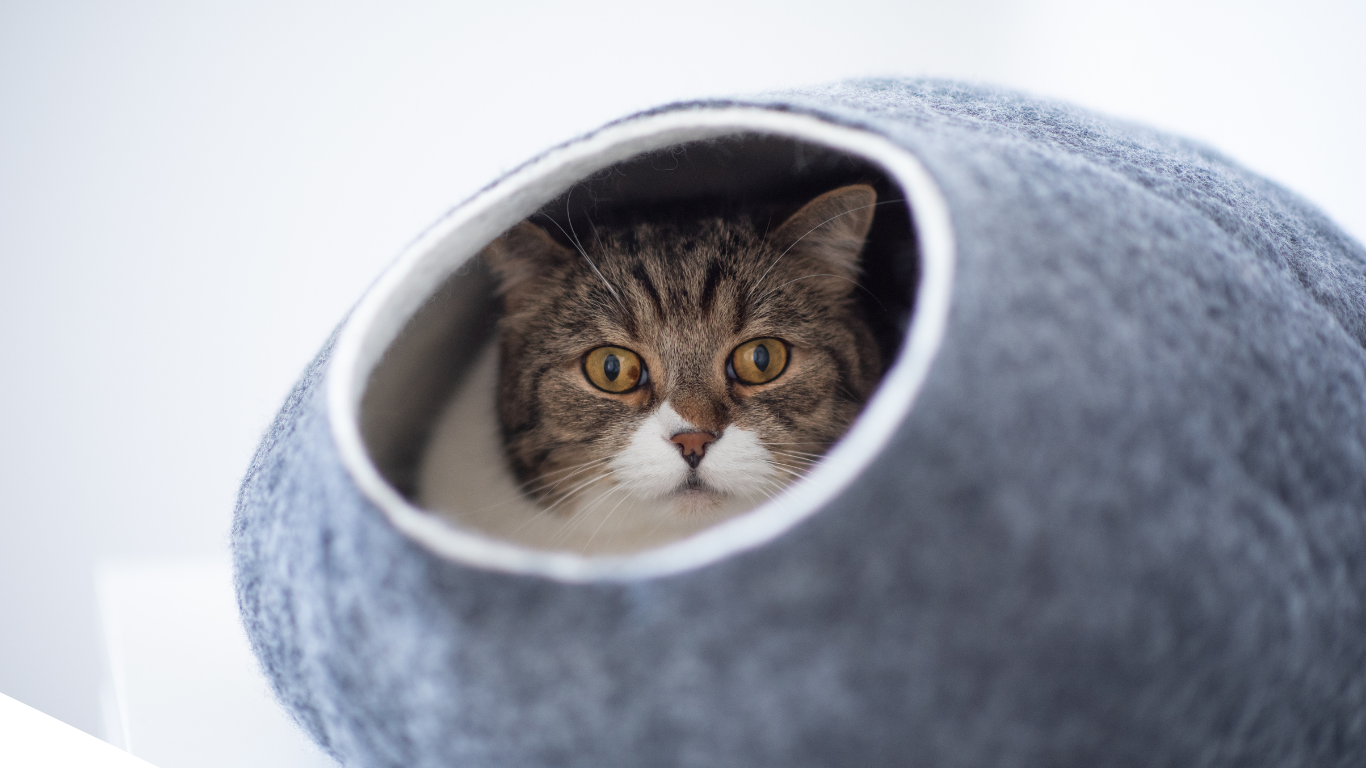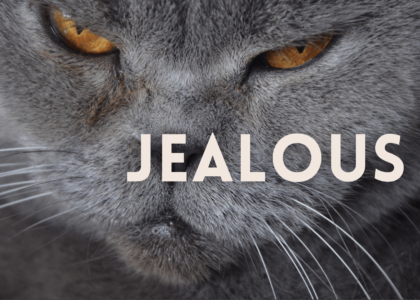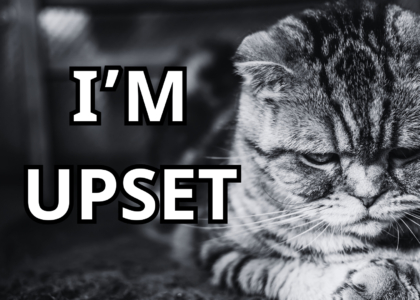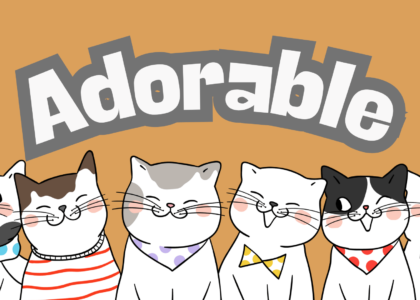If you’ve ever caught your cat curling up in a cardboard box, burrowing under a blanket, or sneaking into a closet, you’ve witnessed their natural love for enclosed spaces. Cats instinctively seek out cozy, confined areas to feel secure, warm, and undisturbed. This is where cat caves come in—a stylish and functional alternative to cardboard boxes and random hiding spots.
But are cat caves actually good for cats? Do they provide real benefits, or are they just another trendy pet product? As cat owners, we want the best for our feline friends, ensuring their comfort, happiness, and well-being.
In this article, we’ll explore whether cat caves live up to the hype. We’ll dive into feline behavior, the pros and cons of cat caves, and how to choose the right one for your kitty. By the end, you’ll have a clear answer on whether a cat cave is worth adding to your home. Let’s get started!
1. Understanding a Cat’s Natural Behavior
Before deciding if a cat cave is a good investment, it’s important to understand why cats are drawn to small, enclosed spaces in the first place. Unlike dogs, who often prefer open, social environments, cats have an instinctive need for privacy and security. Their behavior is deeply rooted in their evolutionary history, influencing how they interact with their surroundings.
1.1 Why Do Cats Like Enclosed Spaces?
Cats are both predators and prey in the wild, and this dual role shapes many of their behaviors—even in the comfort of our homes. In their natural environment, wild cats seek shelter in dens, tree hollows, or thick vegetation to stay hidden from potential threats while also having a secure spot to rest. This instinct hasn’t disappeared, even in domesticated cats.
Here’s why enclosed spaces, like cat caves, appeal to cats:
- Security and Safety: Cats feel more at ease when they have a space that limits their exposure to threats. Being in an enclosed area allows them to observe their surroundings without feeling vulnerable.
- Reduced Stress and Anxiety: When a cat is overwhelmed—whether by loud noises, unfamiliar guests, or household chaos—retreating to a secluded space can help them feel calm.
- Comfort and Warmth: Small spaces help cats retain body heat, making them ideal for staying cozy, especially in colder weather.
In fact, a study conducted by Utrecht University in the Netherlands found that shelter cats given hiding spots adapted to their environment faster and exhibited lower stress levels compared to those without them. This suggests that having a dedicated enclosed space, like a cat cave, could contribute to a cat’s overall well-being.
1.2 Do All Cats Like Hiding Spots?
While many cats naturally gravitate toward enclosed spaces, not all cats have the same preferences. Some love burrowing into tight spots, while others prefer stretching out in the open. Several factors influence a cat’s comfort level with confined areas:
- Personality: Some cats are naturally more outgoing and confident, while others are shy and prefer solitude. Timid cats often benefit more from having a cat cave as a safe retreat.
- Age and Health: Older cats, or those with arthritis, might prefer soft, insulated spots for comfort. Kittens, on the other hand, often enjoy hiding as part of their playful nature.
- Breed Differences: Some breeds, like the Scottish Fold and Ragdoll, are known for being more relaxed and may love the coziness of a cat cave. More active breeds, such as Bengals or Abyssinians, might prefer elevated perches instead.
- Previous Experiences: A cat that has experienced trauma or lived in a shelter may find comfort in enclosed spaces, while others that have always had free access to open areas may not show much interest.
Understanding your cat’s unique behavior and preferences will help determine if a cat cave is a good fit. While some cats might immediately curl up inside, others may need encouragement to explore and use it.
By recognizing the deep-rooted instincts behind your cat’s love (or disinterest) in enclosed spaces, you’ll be better equipped to decide whether a cat cave will truly benefit your feline friend. Next, we’ll break down exactly what a cat cave is and how it compares to other common cat beds.
2. What Is a Cat Cave?
Cat caves are more than just another pet bed—they’re designed to cater to a cat’s natural instincts for security, warmth, and privacy. Unlike traditional open cat beds, which leave your feline exposed, cat caves provide a semi-enclosed, den-like structure where cats can retreat and feel safe.
But what exactly makes a cat cave different from other sleeping spots? Let’s take a closer look.
2.1 Definition and Features
A cat cave is a small, enclosed sleeping area designed specifically for cats. Typically made from soft, insulating materials like felted wool or plush fabric, cat caves offer a warm and comfortable hideaway. They come in various shapes, but most feature a dome-like structure with a single entrance, allowing the cat to peek out while still feeling hidden.
Here’s what sets cat caves apart from other types of cat beds:
- Enclosed Design: Unlike open beds or cushions, cat caves give cats a sense of security and privacy.
- Heat Retention: Many cat caves, especially wool-based ones, trap body heat, keeping your cat warm in colder months.
- Soft & Pliable Structure: Most cat caves are flexible, allowing cats to adjust their position comfortably.
- Minimalist & Stylish: Many cat caves are designed to blend well with modern home décor while providing functionality.
While the name “cat cave” is often used to describe any enclosed pet bed, there are a few different types available, each catering to different feline preferences.
2.2 Types of Cat Caves
There are several variations of cat caves, depending on the materials, shape, and features:
1. Woolen Cat Caves
- Made from 100% felted wool, these are the most popular type of cat caves.
- Naturally self-insulating, breathable, and odor-resistant.
- The soft yet firm structure allows cats to burrow inside or flatten it into a regular bed.
2. Plush & Fabric Cat Caves
- Made from synthetic materials like fleece or microfiber.
- Provides a soft, cushioned interior for extra comfort.
- Often collapsible for easy storage.
3. Enclosed Plastic or Rattan Cat Caves
- Made from hard materials like plastic, wicker, or rattan.
- More structured and durable but may lack the softness of woolen options.
- Some designs include cushions or blankets inside for added comfort.
4. Heated Cat Caves
- Comes with built-in heating pads or self-warming materials.
- Ideal for senior cats or those prone to feeling cold.
5. DIY & Repurposed Cat Caves
- Some cat owners create makeshift caves using cardboard boxes, blankets, or small tents.
- While not as durable, DIY options can still provide a cozy hideout.
Which Type of Cat Cave Is Best?
The best cat cave depends on your cat’s habits and needs. If your cat loves warmth and security, a woolen or plush cave may be ideal. For cats that like firmer, structured hideouts, a wicker or plastic model might work better.
Understanding the different types of cat caves will help you make an informed choice. In the next section, we’ll explore the benefits of cat caves and why they might be the perfect addition to your feline’s environment.
3. The Benefits of Cat Caves for Cats
If you’ve ever seen your cat squeeze into a cardboard box or burrow under a pile of blankets, you already know how much felines love small, enclosed spaces. Cat caves take this natural preference and turn it into a dedicated, cozy retreat designed for both comfort and security. But beyond just being a cute place for your cat to nap, cat caves offer several real benefits that can improve their well-being.
3.1 Comfort and Warmth
Cats are known for seeking out warm spots, whether it’s a sunlit windowsill or the top of your laptop. Cat caves, especially those made of wool or insulated materials, provide a naturally warm environment by trapping body heat.
- Ideal for colder climates – Woolen cat caves, in particular, help maintain warmth without overheating, making them perfect for winter months.
- Great for senior cats – Older cats, especially those with arthritis, benefit from the warmth and cushioning that cat caves provide, easing joint pain and stiffness.
- Self-warming properties – Unlike heated beds that require electricity, wool cat caves naturally regulate temperature, offering a sustainable warmth solution.
3.2 Stress Reduction and Anxiety Relief
Cats can easily become stressed due to loud noises, new environments, or even changes in their daily routine. A cat cave acts as a safe haven where they can retreat and feel protected.
- Perfect for nervous or shy cats – Cats that are naturally timid or take longer to warm up to people benefit from having a designated hiding space.
- Helps with multi-cat households – If you have multiple cats, providing a separate, enclosed area can help prevent territorial disputes and reduce stress.
- Supports adjustment in new environments – Whether moving to a new home or introducing a cat to a new family, a familiar, enclosed space can provide a sense of comfort.
Studies have shown that shelter cats with access to hiding spaces adapt faster and show lower stress levels compared to those without. This highlights the importance of enclosed areas like cat caves for a cat’s emotional well-being.
3.3 Better Sleep Quality
Cats spend an average of 12 to 16 hours a day sleeping, and having a comfortable, undisturbed place to rest is crucial for their health.
- Undisturbed naps – A cat cave shields them from household activity, reducing the chances of being startled awake.
- Encourages deeper sleep – The enclosed, quiet space allows them to enter deeper sleep cycles, which is essential for growth, healing, and overall health.
- Provides a sense of ownership – Unlike a shared couch or blanket, a cat cave belongs solely to them, reinforcing their sense of security.
3.4 Encouraging Natural Behaviors
Cats have strong instincts that are still present despite domestication. A cat cave supports some of their most primal behaviors:
- Denning behavior – In the wild, cats seek out small, enclosed spaces to rest and hide. A cat cave mimics this instinct.
- Territory marking – Cats love having personal spaces they can claim as their own, which is why they rub their scent on their favorite spots. A cat cave gives them a place that is exclusively theirs.
- Hunting instincts – Some cats enjoy using their cave as a stalking ground, hiding inside before pouncing on a toy or a passing sibling cat.
3.5 Protection from Household Disturbances
A cat cave isn’t just about comfort—it can also shield your cat from external stressors, such as:
- Loud noises – Thunder, fireworks, or vacuum cleaners can easily startle cats. A cat cave provides a sound-dampening retreat.
- Guests or other pets – If your cat is wary of strangers or doesn’t get along with a dog, a cat cave offers a private escape.
- Small children – If you have young kids who love to chase or pick up the cat, a cat cave signals a “Do Not Disturb” zone.
Are Cat Caves Worth It?
For most cats, the benefits of a cat cave outweigh any drawbacks. Whether your cat enjoys warmth, needs a safe retreat, or simply loves cozy spots, a cat cave provides an excellent solution. In the next section, we’ll discuss potential downsides and how to determine if a cat cave is right for your feline friend.
4. Potential Downsides of Cat Caves
While cat caves offer numerous benefits, they aren’t a one-size-fits-all solution. Some cats may not take to them, and there are a few practical concerns to consider before purchasing one. Understanding these potential downsides can help you make an informed decision and avoid wasting money on something your cat won’t use.
4.1 Some Cats May Not Like Them
Just because cat caves are designed to appeal to feline instincts doesn’t mean every cat will love them. Some cats prefer sprawling out in open spaces rather than curling up in an enclosed spot.
- Personality differences: Outgoing, confident cats may prefer perches, windowsills, or open beds instead of hiding away.
- Past experiences: Cats who have never used enclosed beds may be hesitant to enter a cat cave.
- Preference for elevated spots: Some cats feel safer in high places rather than inside confined areas, favoring cat trees or shelves over enclosed beds.
Solution: If your cat doesn’t immediately use the cat cave, try placing it in their favorite spot, adding their blanket, or using catnip to encourage exploration. However, if they still ignore it after several weeks, it may not be the best choice for them.
4.2 Maintenance and Cleaning Issues
Cat caves, especially those made from wool or fabric, tend to collect fur, dust, and odors over time. Unlike plastic or machine-washable pet beds, many woolen cat caves require special care.
- Fur accumulation: The enclosed nature of a cat cave means it traps more fur, requiring frequent cleaning.
- Odor retention: If not cleaned regularly, it can develop a musty smell due to trapped dander and oils from your cat’s fur.
- Difficult to wash: Many wool cat caves are not machine washable, requiring handwashing and air drying.
Solution: If hygiene is a concern, choose a machine-washable cat cave or one with a removable cushion for easy cleaning. Regularly vacuuming or lint-rolling the inside can also help manage fur buildup.
4.3 Material Sensitivity and Durability Issues
The materials used in cat caves can impact their longevity and your cat’s comfort.
- Wool allergies: While rare, some cats may be sensitive to wool, leading to mild skin irritation or sneezing.
- Durability concerns: Some cats, particularly those who love to knead, bite, or scratch, may damage soft wool caves over time. Clawing can cause the fabric to thin or tear.
- Chemical-treated fabrics: Low-quality synthetic cat caves might contain dyes or chemicals that could be harmful if ingested.
Solution: Opt for high-quality, natural wool cat caves or hypoallergenic, chemical-free fabrics. If your cat tends to scratch a lot, look for a sturdier option like rattan or a reinforced fabric model.
4.4 Space Considerations
While cat caves are compact, they still take up floor space. If you live in a small apartment or already have multiple pet accessories, adding a cat cave might feel cluttered.
- Takes up valuable space: Unlike wall-mounted cat beds or trees, a cat cave requires a dedicated area on the floor.
- Can be ignored: If your cat prefers the couch, windowsill, or your bed, the cave might just sit unused, taking up space.
Solution: Place the cat cave in an area your cat already enjoys, such as near a window or in a quiet corner. If space is a concern, consider collapsible or multi-purpose designs that can be stored away when not in use.
4.5 Can Be Pricey
High-quality cat caves, particularly those made from felted wool, can be expensive compared to basic pet beds. Some premium models cost upwards of $50–$100, which might not be justifiable if your cat doesn’t end up using it.
- Higher cost than regular cat beds
- Potentially wasted money if the cat ignores it
- Cheaper options may lack durability or comfort
Solution: If you’re unsure whether your cat will use a cave, start with an affordable option or a DIY version using blankets or a small box. This way, you can test their interest before investing in a pricier one.
Should You Get a Cat Cave Despite the Downsides?
While cat caves have a few potential drawbacks, they can still be an excellent investment for cats that enjoy enclosed, cozy spaces. The key is understanding your cat’s preferences and choosing the right size, material, and design to suit their needs.
In the next section, we’ll go over how to pick the perfect cat cave and tips for introducing it to your feline friend!
5. Choosing the Best Cat Cave for Your Cat
With so many cat cave options on the market, finding the right one for your feline friend can feel overwhelming. The best cat cave will depend on your cat’s personality, size, and sleeping preferences. Below, we’ll break down the key factors to consider and recommend some of the best cat caves available.
5.1 Key Factors to Consider
When choosing a cat cave, keep the following in mind:
1. Size and Entryway Dimensions
- The cave should be spacious enough for your cat to enter and turn around comfortably.
- If you have a large cat (over 15 lbs) or multiple cats that like to snuggle together, opt for a larger-sized cave.
- The entry hole size should allow easy access—avoid caves with tiny openings that might discourage use.
2. Material Type and Comfort
- Wool cat caves (like those made from Merino wool) are self-warming, breathable, and odor-resistant—perfect for colder climates.
- Plush or cushioned caves provide extra softness and are ideal for cats that like sleeping on beds or sofas.
- Rugged materials (such as felt or structured foam) work well for cats that like to scratch or knead.
3. Ease of Cleaning and Durability
- Some cat caves, especially those made of wool, require handwashing, which may not be ideal if you want a low-maintenance option.
- Look for machine-washable or detachable cushion designs for easier cleaning.
- If your cat is a scratcher, choose a more durable fabric that can withstand wear and tear.
4. Shape and Design Preferences
- Fully enclosed cat caves are best for shy cats that prefer full privacy.
- Tunnel-style or peekaboo designs work well for playful cats who like to explore.
- Soft collapsible caves can be flattened into a bed, making them a versatile choice.
5.2 Top Cat Cave Recommendations
To help narrow your choices, here are three of the best cat caves that cater to different needs and preferences:
1. Best Overall: WINDRACING Cat Cave Bed with Removable Cushion

⭐ Best for small and medium-sized cats who love plush, cozy spaces
Buy here → WINDRACING Cat Cave Bed
Why We Recommend It:
✅ Soft, plush interior with a cushioned pillow for maximum comfort
✅ Removable and washable cushion for easy cleaning
✅ Tent-like structure offers privacy while still feeling breathable
✅ Affordable and stylish, blending well with home décor
This is a great entry-level cat cave for cats who love soft, plush materials but may not like fully enclosed spaces.
2. Best for Large Cats & Multi-Cat Households: CATTASAURUS Peekaboo Cat Cave
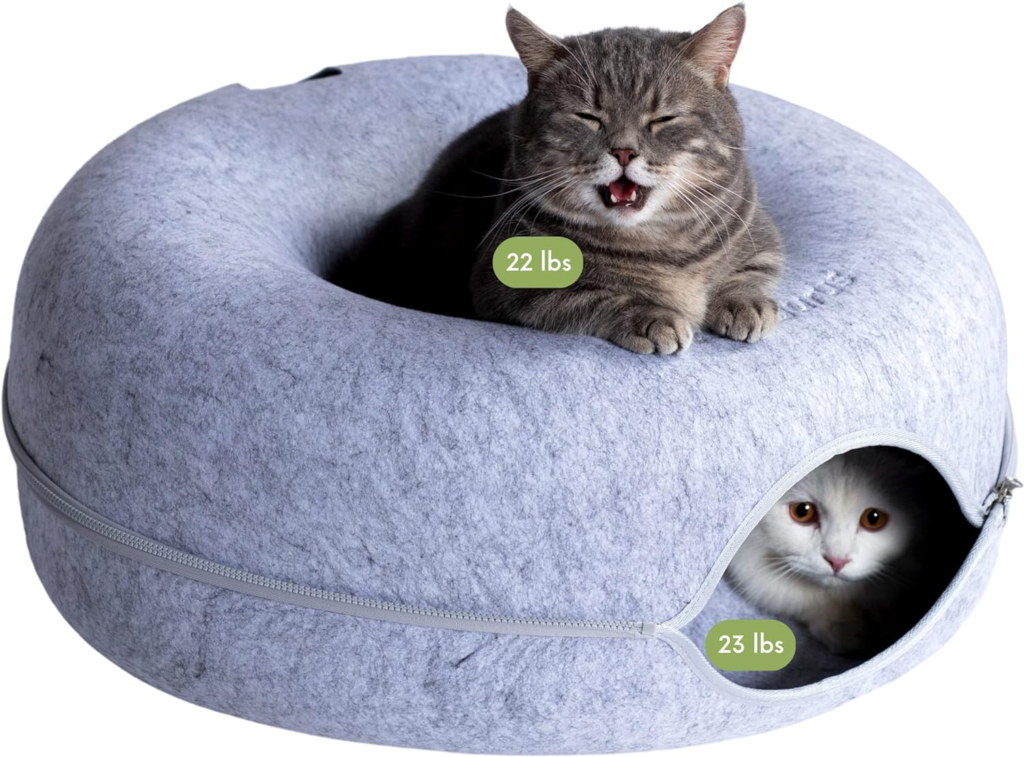
⭐ Perfect for large cats (up to 30-45 lbs) or multi-cat homes
Buy here → CATTASAURUS Peekaboo Cat Cave
Why We Recommend It:
✅ Extra-large design accommodates big cats or multiple felines
✅ Tunnel-style layout encourages interactive play and exploration
✅ Scratch-resistant and washable, making it durable and low-maintenance
✅ Versatile donut shape provides an open yet enclosed feel
If you have a Maine Coon, Ragdoll, or multiple cats who love hiding, playing, and cuddling together, this is a fantastic choice.
3. Best Premium Wool Cat Cave: MEOWFIA Handmade Merino Wool Cat Cave
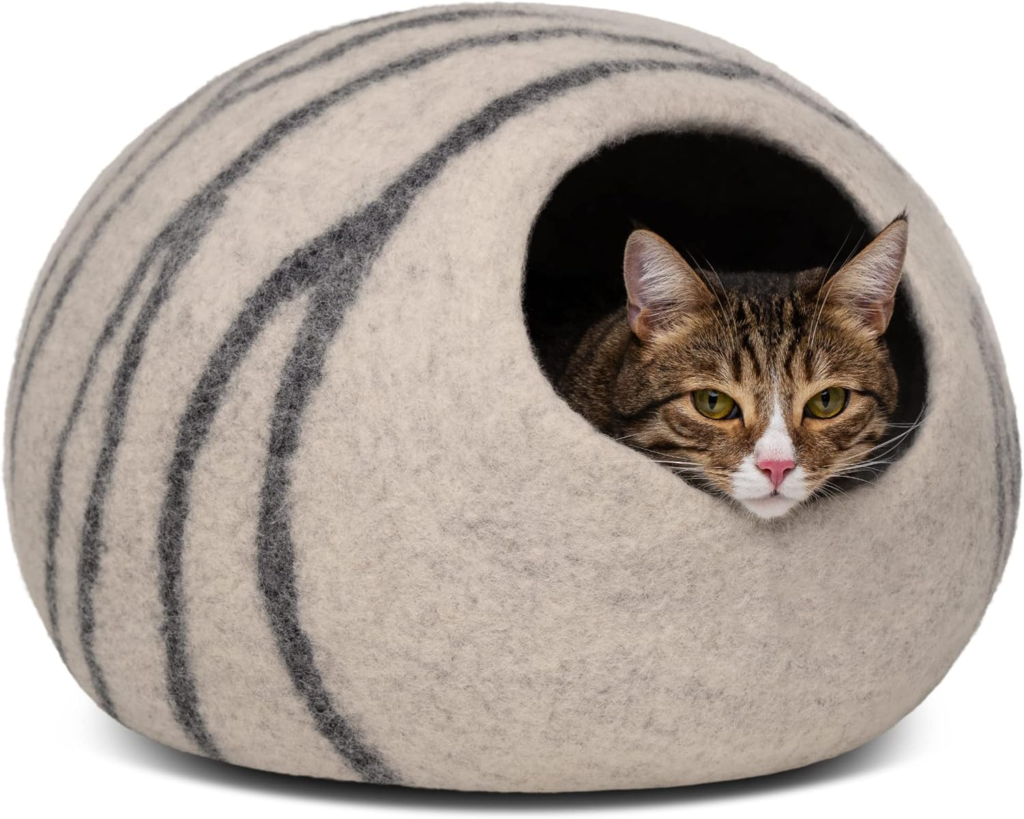
⭐ Ideal for cats who love warmth, luxury, and natural materials
Buy here → MEOWFIA Wool Cat Cave
Why We Recommend It:
✅ Made from 100% natural Merino wool – soft, warm, and eco-friendly
✅ Self-insulating – keeps your cat warm in winter and cool in summer
✅ Durable and handmade – designed to withstand kneading and scratching
✅ Minimalist and modern look, great for stylish homes
This is the best choice if you’re looking for a high-quality, long-lasting cat cave that provides maximum warmth and comfort.
5.3 Tips for Introducing a Cat to a New Cat Cave
Not all cats will take to a new bed or cave right away. Here are a few ways to encourage your cat to use their new cave:
✅ Place it in their favorite resting spot – Cats are creatures of habit, so putting the cave where they already nap increases the chance of them using it.
✅ Add familiar scents – Placing a blanket, towel, or item with your cat’s scent inside the cave can make it more inviting.
✅ Use catnip or treats – Sprinkling catnip inside or placing treats near the entrance can encourage exploration.
✅ Give them time – Some cats may need a few days to weeks before they fully accept a new sleeping spot. Let them discover it at their own pace.
Final Thoughts: Finding the Best Cat Cave for Your Cat
Cat caves can be a fantastic addition to your home, providing comfort, warmth, and security for your feline friend. The key to choosing the best one is to match the design to your cat’s unique preferences—some will love the enclosed coziness of wool caves, while others may prefer the playful tunnel style of a peekaboo bed.
💡 Our Top Picks Recap:
✔ Best Plush & Budget-Friendly Option: WINDRACING Cat Cave Bed
✔ Best for Large Cats & Playful Multi-Cat Homes: CATTASAURUS Peekaboo Cat Cave
✔ Best Luxury & Natural Wool Cave: MEOWFIA Handmade Wool Cat Cave
By choosing the right cave and making it an inviting space, you can give your cat a new favorite spot to relax and feel secure! In the next section, we’ll answer some frequently asked questions about cat caves to help you make the best decision.
6. Final Verdict: Are Cat Caves Good for Cats?
So, are cat caves truly beneficial, or are they just another trendy pet product? After exploring the science behind feline behavior, the benefits, potential downsides, and top product recommendations, the answer is clear: Cat caves are an excellent choice for most cats, but they aren’t for everyone.
Who Benefits the Most from a Cat Cave?
Cat caves are ideal for:
✔ Shy or anxious cats who need a private retreat to feel secure.
✔ Cats that love warm, enclosed spaces and often burrow into blankets or boxes.
✔ Senior cats who need a soft, insulated spot for comfort.
✔ Multi-cat households where some cats may need their own safe space.
✔ Cats living in colder climates, as wool caves provide natural warmth.
If your cat already enjoys hiding in small spaces, a cat cave is likely to be a hit.
Who Might Not Like a Cat Cave?
❌ Cats who prefer to sprawl out in open spaces may ignore enclosed beds.
❌ Extremely social cats who like to stay in high-traffic areas may not use a cave often.
❌ Kittens or highly active cats might prefer interactive spaces like tunnels or cat trees.
For these cats, a plush open bed or an elevated perch may be a better investment.
Final Recommendation
A cat cave can be a fantastic addition to your home if your feline enjoys cozy, enclosed spots. However, it’s important to observe your cat’s habits before buying one. If they frequently seek out enclosed spaces, it’s worth trying a high-quality cat cave like the MEOWFIA Handmade Wool Cat Cave or a versatile option like the CATTASAURUS Peekaboo Cat Cave.
Ultimately, the best way to know if a cat cave is right for your pet is to give it a try. With the right choice and a little patience, you may just discover your cat’s new favorite hideout!
7. FAQs About Cat Caves
If you’re still unsure whether a cat cave is the right choice for your feline friend, here are answers to some of the most common questions cat owners have about them.
1. How do I know if my cat will like a cat cave?
If your cat enjoys hiding in boxes, burrowing under blankets, or curling up in enclosed spaces, they’ll likely enjoy a cat cave. Observing their sleeping habits can help you decide—cats that prefer stretching out may not be as interested.
2. What’s the best material for a cat cave?
Natural wool, such as Merino wool, is one of the best materials because it’s soft, warm, breathable, and naturally odor-resistant. If your cat has sensitivities, opt for a hypoallergenic plush or cotton-lined cat cave like the WINDRACING Cat Cave Bed.
3. Can I make a DIY cat cave at home?
Yes! You can create a simple cat cave by:
- Using a cardboard box lined with a soft blanket.
- Placing a laundry basket upside down with an entry cutout.
- Using a folded blanket over a small tunnel to create a hiding spot.
However, DIY options may not offer the same insulation and durability as a high-quality wool or plush cat cave.
4. How do I clean a cat cave?
It depends on the material:
- Wool cat caves (like the MEOWFIA Handmade Wool Cat Cave) usually require handwashing with cold water and mild soap.
- Plush or fabric cat caves can often be machine-washed on a gentle cycle.
- Hard-shell or synthetic material caves can be wiped down with a damp cloth.
Regular cleaning prevents fur buildup and odor.
5. Can cat caves help with separation anxiety?
Yes, having a familiar, enclosed space can comfort cats who experience anxiety when left alone. Adding a blanket or an item with your scent inside can make it even more reassuring.
6. Do multi-cat households need multiple cat caves?
If you have multiple cats, it’s best to provide at least one cave per cat to prevent territorial disputes. A larger option like the CATTASAURUS Peekaboo Cat Cave can accommodate multiple cats that like to snuggle together.
7. Where should I place a cat cave in my home?
To encourage your cat to use the cave, place it:
- Near their favorite sleeping spot.
- In a quiet corner where they won’t be disturbed.
- Near a heat source (but not too close to radiators or direct sunlight).
Avoid placing it in high-traffic areas where your cat might feel exposed or stressed.
8. My cat isn’t using the cat cave—what should I do?
Some cats take time to adjust. Try these tips:
- Add catnip or treats inside the cave to make it more enticing.
- Place a blanket or item with their scent inside to make it feel familiar.
- Move the cave to a different location where your cat naturally sleeps.
- Give them time! Some cats take a few days or even weeks to start using a new bed.
9. Are cat caves suitable for all seasons?
Most cat caves are great year-round. Wool caves keep cats warm in winter and cool in summer due to their natural insulation properties. For extra warmth, consider a heated cat cave in colder months.
10. Are cat caves worth the price?
If your cat enjoys enclosed spaces, then yes, they’re worth the investment. A high-quality cat cave like the MEOWFIA Handmade Wool Cat Cave is durable and provides long-term comfort. If you’re unsure, starting with a more affordable option like the WINDRACING Cat Cave Bed is a great way to test your cat’s interest.
By choosing the right cave and placing it strategically, you can ensure your cat gets the most out of their cozy new hideaway!
Conclusion
Cat caves are more than just a trendy pet accessory—they cater to a cat’s natural instincts for security, warmth, and privacy. Whether your feline is shy, playful, or a seasoned nap enthusiast, a well-chosen cat cave can provide them with a safe and cozy retreat where they can truly relax.
While not every cat will take to a cat cave immediately, the key is to observe their habits and choose the right design for their needs. Options like the MEOWFIA Handmade Wool Cat Cave are perfect for cats that love warmth and enclosed spaces, while the CATTASAURUS Peekaboo Cat Cave is great for multi-cat households and playful kitties. If you’re on a budget or prefer a plush bed with easy maintenance, the WINDRACING Cat Cave Bed is a fantastic option.
At the end of the day, the best way to find out if a cat cave is right for your pet is to give it a try. With a little patience and the right setup, you may just discover your cat’s new favorite spot to rest, hide, and recharge.
💡 Now it’s your turn! Does your cat already love hiding in small spaces? Try introducing a cat cave and see if it becomes their new go-to nap spot! 🐾


